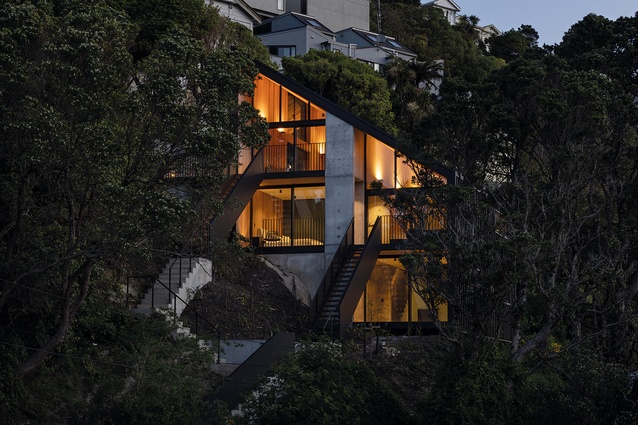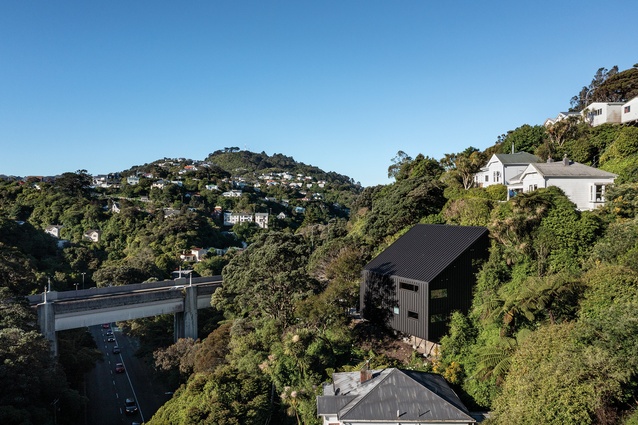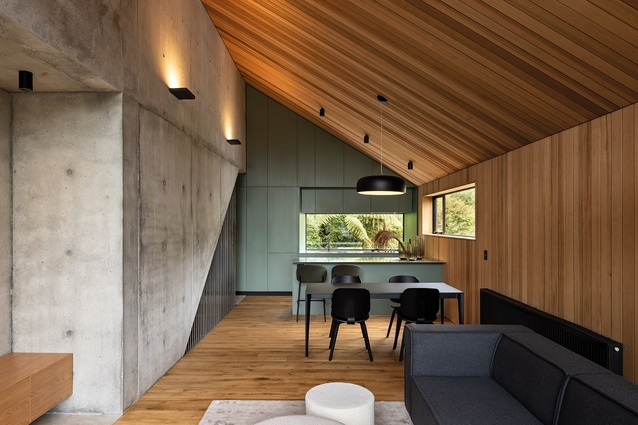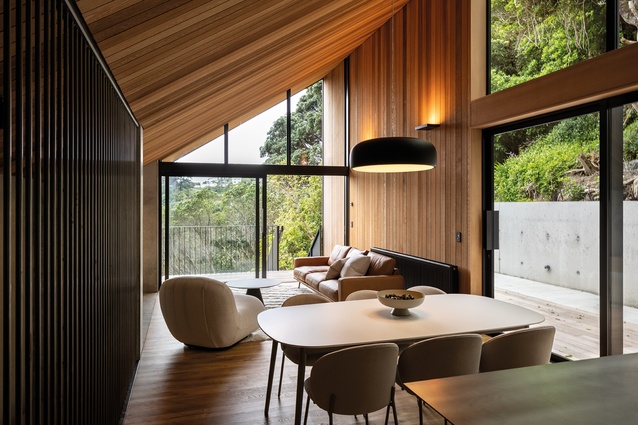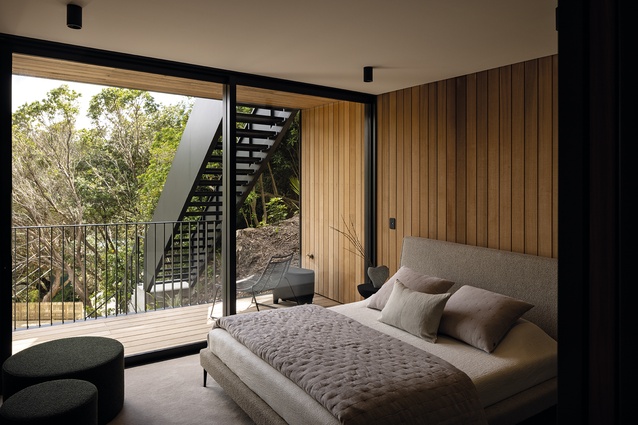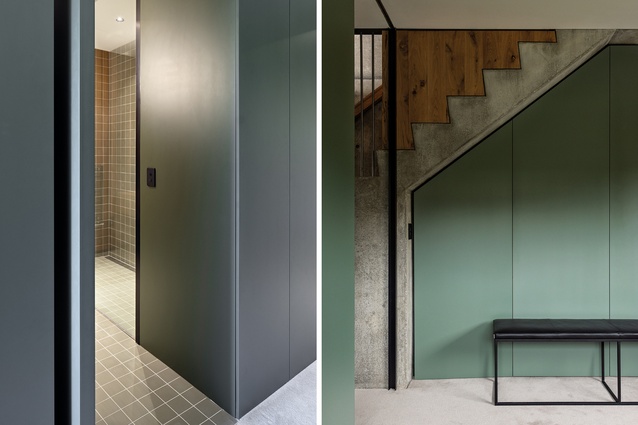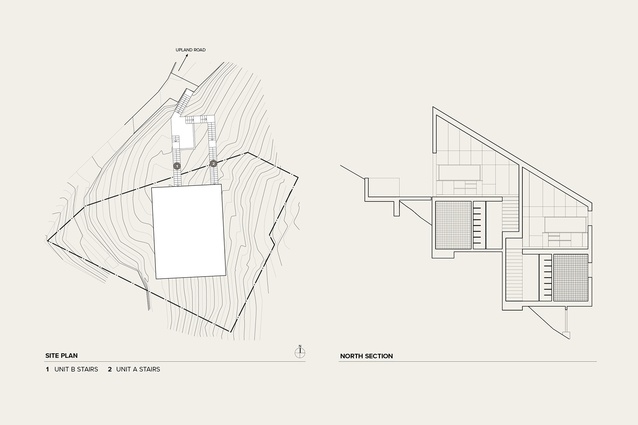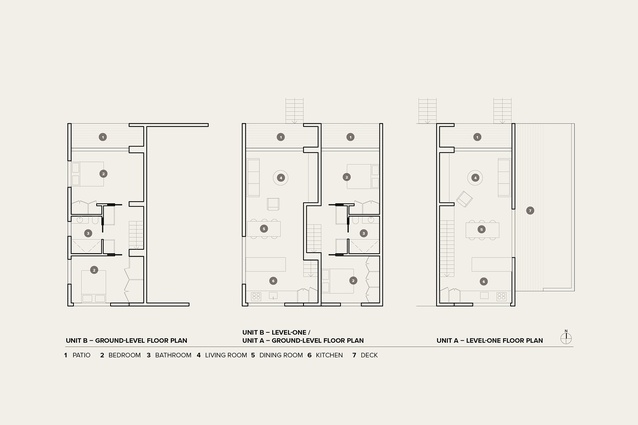Duplex with a difference
Guy Marriage is impressed by the joy of Patchwork Architecture’s three-dimensional, Escher-like cliff-side edifice, Party Wall, in Wellington’s Kelburn.
Kelburn is a wildly hilly suburb of well-heeled Wellington, home to gaily painted timber villas perched atop fiercely pōhutukawa’d slopes, accessed via infeasibly large numbers of complex, interconnecting walkways. Almost no one has level, walk-on access and, for many houses, maintenance to the timber weatherboards and fretwork is long overdue. Car-parking is precariously perched on the sides of road reserves or hugs tightly to the sides of skinny, winding roads.
Patchwork Architecture’s pair of townhouses in Upland Road conforms to the trend in one way and strongly bucks it in the next. Cue complex staircases for access and a precarious parking pad for cars. But cue, also, a massively comforting concrete floor and centrally located party wall, anchoring the two homes firmly to the rock below. A word of warning though – this is no normal party wall. This is more like Machu Picchu.
Patchwork is used to building on hilly sites; the practice started with the self-built Dog Box on the side of a cliff in Whanganui and then built the ingenious Stealth Bomber house at the top of a cliff in Island Bay. Now, the firm has continued this trend in Kelburn on its steepest site yet, in a project for youthful developer Luke Pierson, dubbed Party Wall.
This little piece of sophistication poised in the slipstream lies between the tangled Victorian roading of the urban jungle and the wild green yonder, nestled on the cliff side near the formidable concrete masterpiece of the 1931 Kelburn Viaduct. Facing north out to the sun, hidden in plain sight, to the south and west, the site descends vertiginously to the green-clad slopes below.
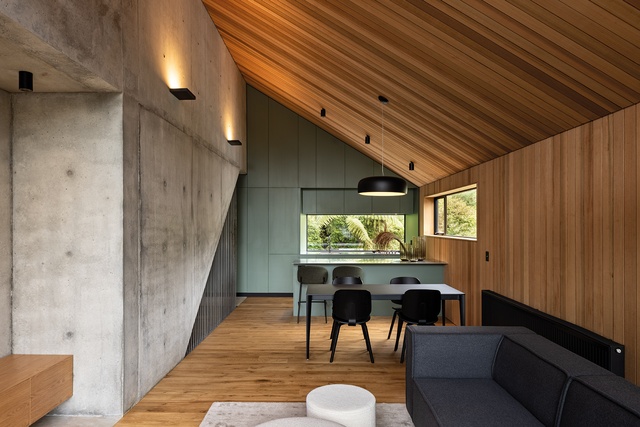
It’s a duplex development with a difference. Each house has two bedrooms and a bathroom downstairs, with open-plan kitchen-dining-living room upstairs, but, while the two units share the party wall, one house sits a whole floor higher than the other. The dividing wall becomes a three-dimensional Escher construction of joy, enabling each set of internal stairs to be stacked above the other, hidden within the solid concrete.
Project architect Ben Mitchell-Anyon’s party wall design is doing all the heavy lifting on the job; it’s a work of well-crafted genius, darting in and out to encompass not only a staircase on each side but also recesses for storage, stereo, TV, lights, door jambs, books and more, interlocking the two dwellings together like a piece of careful Japanese shiguchi joinery. It is a true collaboration between engineer Spencer Holmes, Patchwork Architecture and Dorset Construction, with steelwork by Whanganui steel fabricators Garmac keeping the forms sharp and crisp.
Aerial stairs crisscross the site, starting off with crisp concrete flights and then quickly changing to even crisper steel. Well proportioned decks face north from each house, while the eastern-most unit also has a large side deck, all carefully detailed and constructed. With external Espan 340 cladding in a dusky coat of FlaxPod to roof and sides, and a cleverly hidden gutter system, there’ll be no repainting or maintenance needed here.
In characteristic Patchwork style, the formwork to the concrete has been immaculately detailed with perfectly positioned tie-bolt connections aligned and integrated with twin delicate uplighters. It’s probably the most comprehensive set of formwork drawings I’ve ever seen but, if you want perfection from the builder, then the drawings need to be perfect too. This is concrete as it wants to be: a smooth amorphous wall of human-made artificial stone, uniformly grey and neutral, set off against cedar-clad ceilings and walls. A large part of the party wall’s success is the superb quality of the construction.
Incisions and rebates in the concrete are crisp and well defined, gutsy and sophisticated at the same time. The formwork construction must have been intense — my congratulations to Dan Santure and the hard-working team from Dorset Construction. Complexities of the concrete party wall aside, the rest of the house appears deceptively simple. It takes a lot of hard work to make everything look effortlessly integrated.
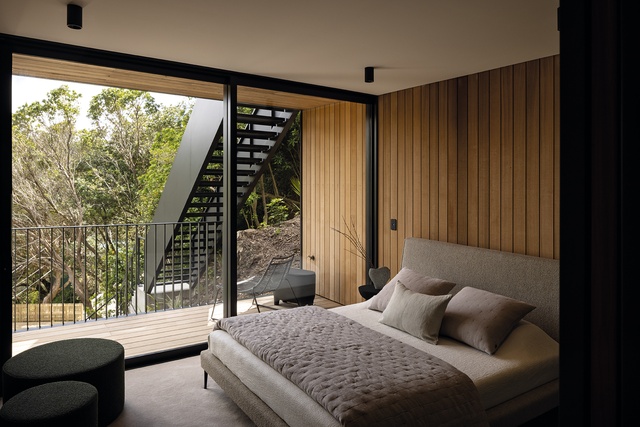
The plan has the living spaces upstairs and the bedrooms downstairs. It creates the unusual situation that you have to climb high on the outside to enter and then descend internally to the bedrooms — on a rainy night, I might be tempted to enter the house directly via the bedroom door, perhaps. Of course, it makes sense for so many reasons in planning terms and internal stair positions and, as site architect Sally Ogle notes, to add extra hall space downstairs would have eaten up precious width, making the building too wide to fit on the precariously narrow site.
Between the two bedrooms, there is a simple volume of green-painted joinery incorporating wardrobes, laundry and other storage on the outside. Inside, the timber box is a green-tiled bathroom with cedar walls: warm, spacious, safe and comfortable. Goldmark Group excelled on this project with impeccable joinery to these bathrooms. Upstairs in the kitchen is another green-painted MDF box of storage joinery and, behind the super-deep, wide benchtop, an inset window doubles as a splashback of live-action greenery. Trees, plants and vines abound along with escapees from the nearby Zealandia Ecosanctuary – kererū, kākā and tūī flirting about, squawking their various guttural songs. I half expect to see a tuatara gaze stonily out of a nearby rocky crevice and it feels as though moa still stalk the land nearby. Despite nearby urban neighbours, the site still feels primeval.
This project ticks so many boxes for densification of our city suburbs. It creates two new houses locked together in an intimate embrace on a spare piece of unused land. It took careful negotiation, several years and much patience but it creates car-parking pads and legal pathways and clears up resource consent anomalies. No heritage villas were harmed in the making of this project and yet more character living has been added. At around 85m2 each, it creates two-bedroomed units at a reasonable price for an exceptionally quality product. But, most of all, it creates two homes, superbly detailed and beautifully well built, for two very lucky owners.

